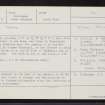Benbecula, Strome Shunnamal
Pictish Symbol Stone (Pictish)
Site Name Benbecula, Strome Shunnamal
Classification Pictish Symbol Stone (Pictish)
Alternative Name(s) Srom Shunamul
Canmore ID 10189
Site Number NF85NW 5
NGR NF 800 560
NGR Description NF c. 800 560
Datum OSGB36 - NGR
Permalink http://canmore.org.uk/site/10189
- Council Western Isles
- Parish South Uist
- Former Region Western Isles Islands Area
- Former District Western Isles
- Former County Inverness-shire
Field Visit (16 July 1915)
Sculptered Stone, Benbecula.
This stone was discovered about a mile and a half due east of the ruined well near Strome Shunnamal: “The slab from Strome Shunnamal is of grey granite, 3 feet long by 2 ½ feet broad, and 8 to 9 inches thick. It bears on one face an incised circle 12 inches in diameter, within which are three smaller circles and a triquetral ornament between them” (1). Besides the large circle there is an oblong incised rectangular figure 13 inches long by 5 inches in breadth, divided into two panels, one of which contains two incised scrolls. The other side of the stone is not sculptured. The stone is now preserved in the National Museum of Antiquities, Edinburgh (No. IB, 37).
RCAHMS 1928, visited 16 July 1915.
OS map: South Uist xlv (unnoted)
(1) Cf. Proc. Soc. Antiq. Scot. VIII, 284-5
Field Visit (8 June 1928)
The Sound of Sunamul is the area of sea centred at NF 803 566, between the island of Sunamul and the mainland of Benbecula. No further information about the find-spot of the stone was discovered.
Visited by OS (R D) 8 June 1928.
External Reference (1980)
It is a slab of grey granite, 0.9m x 0.76m x 0.22m and bears on one face, an incised rectangular symbol, ornamented within and a disc containing 3 smaller ones.
R Jones 1980
Reference (1997)
Class I symbol stone bearing a rectangle above a disc holding three smaller discs.
A.Mack 1997 p.30
Reference (2001)
This symbol-stone (NMS X.IB 37) was presented to the National Museum of Antiquities of Scotland by Alexander Carmichael in 1870. It was found by him some years earlier below high-water level in the tidal channel that separates the islet of Sunamul from the N coast of Benbecula. He described the find-spot as lying 'about a mile or a mile and a half' (1.6km or 2.4km) E of structures then exposed in a large sand-dune in the area now occupied by Benbecula Airport. This suggests that it was in the channel to the S of Sunamul rather than to the W, but it cannot be more closely located. Carmichael noted an adjacent scatter of stones which appeared to be the remains of some artificial structure (i). A rock about 250m N of Sunamul is known as Crois an t-sleuchd ('cross of the prostration, or bowing'), and the traditional site of a cross occupies a knoll overlooking the strand at Gramsdale (NF 8265 5615), about 2.2km to the E (ii). A medieval church dedicated to St Columba is situated at Balivanich, about 2.5 km to the SW (iii).
The stone is a polygonal slab of gneiss, 0.96m high by 0.84m and 0.23m thick (iv). The carved face is level but weathering has exposed several prominent parallel veins of hard stone. At the centre there is an incised circle, 0.31m in diameter, enclosing three 0.13m circles which touch the perimeter (v) and are linked by curved lines to define a central three-armed figure. This motif has a small sinking at the centre and in each of its three terminals. Some 12mm above the circle there is a rectangle measuring 0.32m by 0.12m and divided by an axial line, with simple curvilinear ornament in the upper half.
A small number of disc symbols are known from NE Scotland, and three of them have three internal circles, but they are not linked to define a central motif as on this stone. In contrast, the ornamented rectangle is a neat but very simple form of the symbol (vi). The two symbols are not found in combination elsewhere.
Footnotes:
(i) A A Carmichael 1871, 282-4.
(ii) A Carmichael 1940, 262-3; RCAHMS 1928, No.358.
(iii) Ibid., No.339.
(iv) The slab, as displayed in the Museum of Scotland and described here, has been turned by 90? from its previous alignment
(v) One of the three small circles, which was affected by a hard vein, does not touch the perimeter and is only 0.12m in diameter.
(vi) Allen and Anderson 1903, 2, 58, 66.
(A A Carmichael 1871, 284-5; NMAS 1892, 262; Allen and Anderson 1903, 3, 110-11; RCAHMS 1928, No.356; A Mack 1997, 30).
I Fisher 2001, 108-9.
Desk Based Assessment
NF85NW 5 centred 803 566.
A slab of grey granite, 3ft by 2 1/2ft by 8 to 9ins, with an incised design on one face, was found by Carmichael 'lying on the seashore near the remains of an ancient building' (J R Allen and J Anderson 1903) at Strome Shunnamal, or the Stronce or Sound of Sunnamal, which is on the NE side of Benbecula and is dry at low water. The slab is now in the National Museum of Antiquities of Scotland (NMAS). (IB 37).
Information from OS.
A A Carmichael 1871; J R Allen and J Anderson 1903; RCAHMS 1928.






















